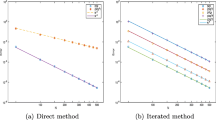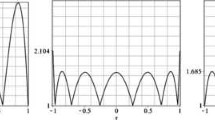Abstract
Given scattered data on the real line, Favard [4] constructed an interpolant which depends linearly and locally on the data and whose nth derivative is locally bounded by the nth divided differences of the data times a constant depending only on n. It is shown that the (n —1)th derivative of Favard’s interpolant can be likewise bounded by divided differences, and that one can bound at best two consecutive derivatives of any interpolant by the corresponding divided differences. In this sense, Favard’s univariate interpolant is the best possible. Favard’s result has been extended [8] to a special case in several variables, and here the extent to which this can be repeated in a more general setting is proven exactly.
Similar content being viewed by others
References
C. de Boor (1974): A smooth and local interpolant with “small” kth derivative. In: Numerical Solutions of Boundary Value Problems for Ordinary Differential Equations (A. K. Aziz, ed.). New York: Academic Press, pp. 177–197.
C. de Boor (1975): How small can one make the derivatives of an interpolating function! J. Approx. Theory, 13:105–116.
C. de Boor (1976): On “best” interpolation. J. Approx. Theory, 16:28–42.
J. Favard (1940): Sur l′interpolation. J. Math. Pures Appl., 19:281–300.
D.W. Holtby (2000): Higher-order estimates for fully nonlinear difference equations I. Proc. Edinburgh Math. Soc. (2), 43:485–510.
D. W. Holtby (2001): Higher-order estimates for fully nonlinear difference equations II. Proc. Edinburgh Math. Soc. (2), 44:87–102.
H. O. Kreiss (1974): Difference approximations for singular perturbation problems. In: Numerical Solutions of Boundary Value Problems for Ordinary Differential Equations (A. K. Aziz, ed.). New York: Academic Press, pp. 199–211.
T. Kunkle (1992): Lagrange interpolation on a lattice: Bounding derivatives by divided differences. J. Approx. Theory, 71:94–103.
T. Kunkle (1994): Using quasi-interpolants in a result of Favard. In: Approximation and Computation (R. V. M. Zahar, ed.). ISNM, Vol. 119. Basel: Birkhäuser Verlag, pp. 353–357.
Author information
Authors and Affiliations
Corresponding author
Additional information
Communicated by Peter Oswald.
Rights and permissions
About this article
Cite this article
Kunkle, T. Favard’s interpolation problem in one or more variables. Constr. Approx. 18, 467–478 (2002). https://doi.org/10.1007/s00365-001-0015-7
Received:
Revised:
Accepted:
Issue Date:
DOI: https://doi.org/10.1007/s00365-001-0015-7




